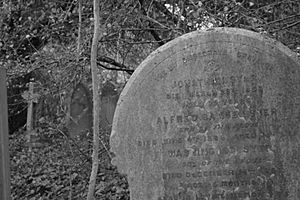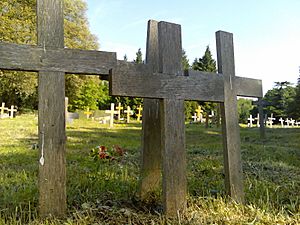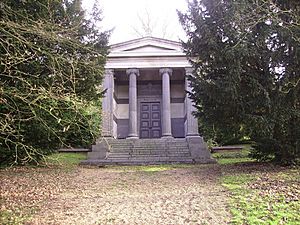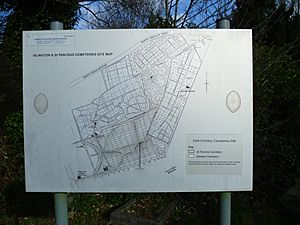St Pancras and Islington Cemetery facts for kids
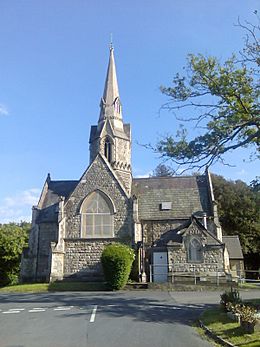
Islington Chapel, English Heritage Listed Building Grade II
|
|
| Details | |
|---|---|
| Established | 1854 |
| Location | |
| Country | England |
| Type | Public |
| Size | 190 acres (77 ha) |
| No. of interments | around 1 million |
St Pancras and Islington Cemetery is a very large cemetery in East Finchley, North London. Even though it is located in the London Borough of Barnet, it is managed by two other London areas: Camden and Islington. These two parts used to be separated by a fence, but it has now been removed. You can still see where the line used to be.
This cemetery is the third-largest single cemetery serving London. It is also the biggest in the UK when you count the number of burials and cremations, with about one million people laid to rest here. The cemetery is a special place for history and nature. It is listed as Grade II* on the English Heritage Register of Parks and Gardens of Special Historic Interest in England. It was also the first cemetery in London to be owned by the public.
Contents
Exploring the Cemetery
Chapels and Buildings
Cemeteries often have chapels, which are small churches or buildings used for funeral services. The St Pancras Anglican chapel is a beautiful building built in 1853. It has a unique design with a central tower and spire. This chapel was used by both St Pancras and Islington until 1896.
There was also a Nonconformist chapel, built around the same time, but it was taken down in the 20th century. Another Roman Catholic chapel was built in 1896 but has also been demolished. Many of the tombs in the Roman Catholic area are decorated with angels.
War Graves and Heroes
St Pancras Cemetery has a special section for war graves. These are the graves of soldiers who died in the First and Second World Wars. There are over 100 graves here. Some headstones were moved here from other parts of the cemetery to keep them safe.
A memorial wall lists the names of 27 soldiers whose graves could not be marked individually. It also remembers six soldiers from the First World War buried in the nearby Islington Cemetery. In total, 299 soldiers from the First World War and 207 from the Second World War are remembered or buried here. A very brave soldier named John Ross, who received the Victoria Cross medal, is buried here.
Islington Cemetery also has many war graves, with 334 from the First World War and 265 from the Second World War. These graves are spread out across the cemetery. A special wall lists the names of those whose graves could not be marked.
Special Tombs and Memorials
You can find some very interesting tombs and memorials in the cemetery. The Mond Mausoleum is a grand tomb built in the style of ancient Greek temples. It was made for Ludwig Mond, a famous German-born chemist and businessman.
There is also a memorial for William French. He died in 1896 while trying to save a dog from drowning. People paid money to build this monument in his honor.
Who is Buried Here?
St Pancras and Islington Cemetery is one of the largest cemeteries in the UK. It has about 812,000 burials and 56,000 cremations since it opened in 1854. If you include people moved from older churchyards, the number goes over one million!
Because of the areas it served, the cemetery holds the history of many people from Victorian London. You can see all kinds of tombs and monuments, from simple ones to very grand ones. The biggest and most impressive tombs are often found along the main roads inside the cemetery.
There are many interesting people buried here, including:
- Henri d'Alcorn, a composer.
- Valentine Bambrick, a soldier who received the Victoria Cross.
- Mathilde Blind, a German-born English poet and writer.
- Ford Madox Brown, a famous artist.
- Henry Croft, the first "Pearly King" (a London tradition).
- William Crump, the first Mayor of Islington.
- Margaret Fairchild, who was the subject of a famous book and movie called The Lady in the Van.
- Sir Eugene Aynsley Goossens, a violinist and conductor.
- John Hickey, a survivor of the famous Charge of the Light Brigade.
- Silas Hocking, a very popular Victorian author.
- Ken "Snakehips" Johnson, a famous dance band leader.
- John Baptista De Manio, an early aviation pioneer.
- Alfred Mond, a director of a large chemical company and a Member of Parliament.
- Ludwig Mond, a wealthy industrialist and humanitarian, who has a large family mausoleum.
- Tiverton Preedy, a clergyman and founder of Barnsley Football Club.
- George Price, an American geneticist.
- George Cuvier "The Boy" Spencer, who brought an early type of bicycle called the velocipede to England.
- Percival "Percy" Spencer, who was buried under a stone hot air balloon, showing his family's interest in ballooning.
Some people were also reburied here from older London churchyards, including those from St Pancras Old Church, St Mary's Church, Islington, and St Luke Old Street.
Nature and Wildlife
The cemetery is not just a place for burials; it's also a wonderful natural space. It has open grassy areas, wetlands, and old woodlands. It is recognized as a very important place for nature conservation.
Caring for Nature
Experts have advised the cemetery owners on how to manage the land to protect its natural features. They make sure to do this while still respecting that it is a burial ground. In recent years, some areas not actively used for burials have been left to grow naturally. This has led to a huge increase in different kinds of wildlife. Many parts of the cemetery now have thick bushes and young trees, which add to the original plants and create a very diverse home for animals.
Plants and Trees
The woodlands here have many different trees like sycamore and ash. You can also find pedunculate oak, hawthorn, and willow. Over time, some beautiful ornamental trees have been planted, such as rows of limes and horse chestnuts, Lawson's cypress, various pines, yew, and even monkey-puzzle trees.
Underneath the trees and along the paths, you can find woodland plants like holly and bramble. There are also pretty flowers like bluebells, pignut, goldilocks buttercup, cuckoo flower, bugle, and wild strawberry. These plants have either spread from nearby woodlands or survived from when the cemetery used to be a farm.
In the north-east part of the cemetery, a stream called Strawberry Vale Brook flows into the open. Here, you can find wetland plants like mature white willow trees, rushes, reedmace, marsh thistle, and great willowherb.
Birds and Animals
The cemetery is home to many birds, including green and great spotted woodpeckers, treecreepers, goldcrests, and kestrels. You might also spot Muntjac deer, which are frequent visitors to the area.


